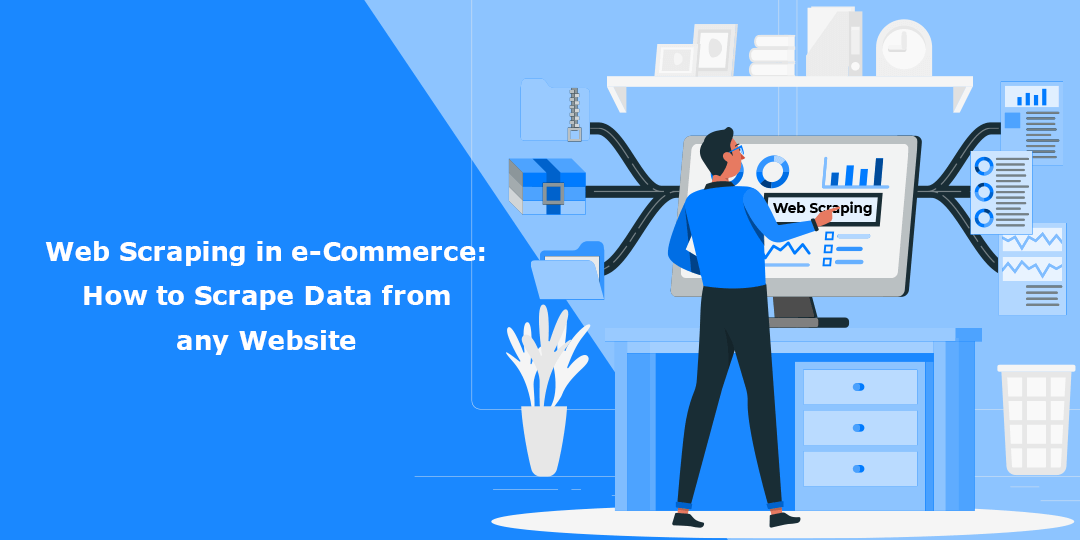In e-commerce, determining customers’ perceptions is critical. Web scraping delivers data from user evaluations and comments to e-commerce sites. This data may improve existing items or create customized new products depending on consumer behaviour and needs. Scraping the Web also gives information on prices, current trends, market dynamics, conflict problems, and the actions of your competitors.
A handful of websites might be restricted in your country, and extracting data might be challenging. Thus, proxies are used by web scrappers to conceal their identity and disguise their traffic as that of ordinary users. This way, they can crawl a website more reliably, significantly lowering the likelihood of your spider being banned or blocked making it a lot easier to scrape data.
Before jumping into an ultimate guide on “How to scrape data from any website?” let’s find out why web scraping is used and its significant advantages.
Why is Web Scraping in e-Commerce used?
We know that web scraping is a technique for extracting vast amounts of data from websites, but why is it necessary to acquire this much data from sites? Let’s have a look at several web scraping advantages to learning more about this:
- You must first comprehend and forecast how your clients respond to price fluctuations to determine the best pricing. Thus, scraping the Web for price comparisons allows you to monitor how customers react to pricing adjustments made by your opponents or adjust your rates and see how it impacts sales.
- Web scraping is used by many firms who employ email as a marketing tactic to acquire email addresses and then send mass emails. This way, they may quickly establish a high-quality email list that may be used for email marketing or as a bespoke audience on Facebook or Google Ads.
- It also has a huge role in job postings. Information about interviews and job opportunities is gathered from several websites and then compiled in one location to be readily available to the user.
- This technique is also used for social media scraping. It helps many businesses and brands see what is trending to arrange their services and products accordingly.
- Web scraping is often used to gather a significant amount of data like statistics, temperature, general information, etc., from websites, which is then processed and used in R & D or website surveys.
Before going into the actual guide, you must know about web scraping tools and their importance in data scrapping.
Web Scraping Tool
A web scraping tool streamlines the process by collecting the information you need from the Web and organizing it in a structured way for processing and storage. Even minor tasks require a scraping tool or web scraping software.
Although you can copy and paste material from specific websites into a file manually, it is a time-consuming and tricky procedure that is likely to make mistakes. The process is automated using a web scraping tool, and you can quickly extract any number of pages into nicely structured spreadsheets or any format you want.
Another option is to buy the data you require from a company that offers a web scrapper service and will extract the data for you. This might be handy for large projects containing tens of thousands of web pages.
How to Scrape Data from any Website?
Scraper tools with no coding are the simplest way to extract data from the Web. Read the following steps and scrape data without coding.
- Locate the desired website.
- Obtain the URLs of the sites from which you wish to extract data. Request these URLs to obtain the page’s HTML.
- Locators can be used to locate data in HTML.
- Save the information as a CSV, JSON, or other structured formats.
On the other hand, Python is now the most preferred language for web scraping. Its versatility, simplicity of scripting, extensive collection of data transformation libraries, and support for the most popular scraping tools, such as Beautiful Soup, Scrapy, and Selenium, are just a few of its advantages. It provides automated web scraping and can help speed up the data collection process. You write your code once, and it will retrieve the data you require as many times from multiple sites. Read the steps below to understand how Python web scrapping tools can be used to scrape data from a website.
- Go to the URL you want to scrape and copy it.
- Analyze the Page.
- Locate the information you wish to extract.
- Write code.
- Run the code to get the data.
- Save the data in the appropriate format.
- That’s it!
Conclusion
So, this was all about web scraping in e-commerce, including web scrapping tools (coding or non-coding) and a detailed guide on how to scrape data from any website. Businesses apply web scraping to communicate with their clients and discover who else is working in their sector, allowing them to improve their products and services.
Data provides organizations with the feedback mechanism they need to respond in the real world rather than assuming scenarios. If you want to stay ahead of your competitors, you should know how to scrape data from any website, and using tools is a great way to do so. Read our detailed guide on web scrapping and employ it in real life to see its impact on your company’s growth in no time.
People Also Asked
Is it possible to scrape Amazon’s website?
You may scrape data from the Amazon website and store it in a JSON format or spreadsheet using web scraping. You may also automate the procedure so that the information is updated weekly or monthly.
Is it worthwhile to learn web scraping?
Yes!! It is well worth the struggle and money to learn the technique. Data is utilized everywhere, and it requires a reliable channel to extract data from numerous websites. You can work as a web scraper or use your talent for your own business.
What is the purpose of data scraping?
Data scraping or web scrapping is importing information from a website into a local file or spreadsheet saved on your computer. It’s one of the most compelling ways to collect data from the Web. It is also used to send that information to another website.









